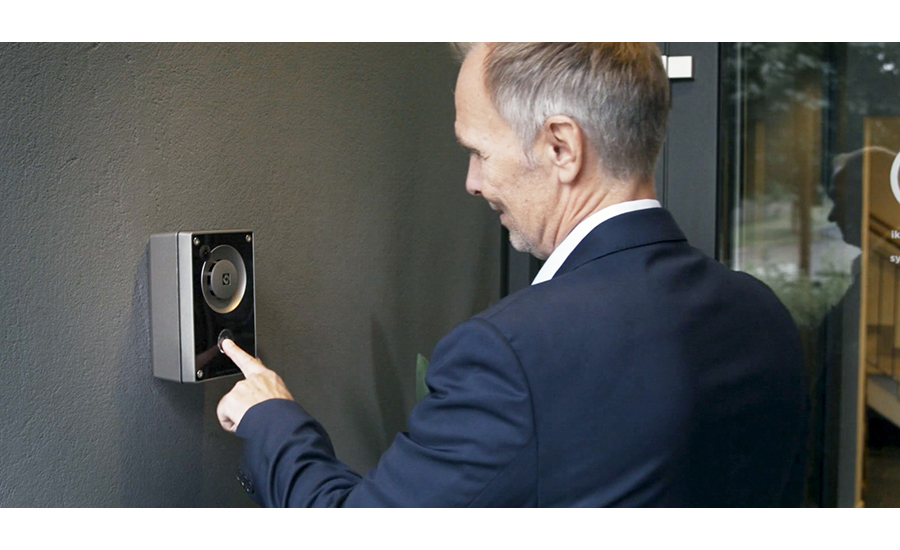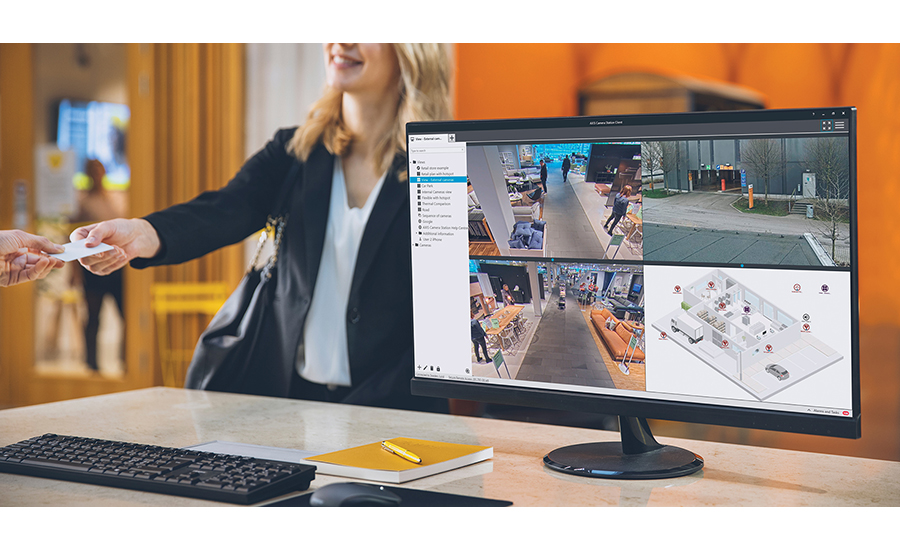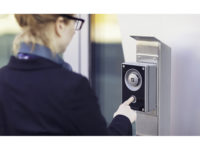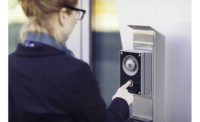Like most other aspects of the electronic security industry, today’s intercoms and entry control systems are capable of much more than simply controlling ingress and egress to a secured area. Customers expect their systems to be accessible from a single platform, where they can not only screen visitors and control physical access, but also view video footage, verify credentials, administer lockdowns and improve processes — typically through the convenience of a smart phone app.
This opens up a wealth of opportunities for security professionals who take the time to understand the long-term needs of their customers and align them with the appropriate technology.
“Today, access control is more than just a method of securing property and assuring authorized residents and personnel can get into areas where they have access,” says Luis Martinez, security solutions consultant at Advant Solutions, Houston. “It also provides opportunities to enhance processes, efficiency and convenience for residents and staff within a building or on a campus. Optimal performance is dependent on pairing the right access control system with the right door hardware and properly maintaining both.”
Video’s Enhanced Role
Tech advances have made achieving this easier and more integrated than ever before. “Many people think of video, audio and access control as disparate systems,” says Aaron Saks, senior product and technical training manager at Hanwha Techwin America, Teaneck, N.J. “We are seeing a convergence of these, as well as a blending of the categories. An intercom is a camera that can work with a phone system, or vice versa.”
“Security used to be mostly about not letting people in. Today, we need to accommodate package and food delivery, which means we’re letting people into a property more than ever before.”
- Luis Martinez, Advant Solutions Inc.
Some of these advances include ultra-wide-angle lenses to capture events in low-light situations, coupled with high-end audio processing to provide echo cancellation so both parties can talk and listen clearly, Saks says.
For example, Hanwha’s integrated “Time of Flight” sensor allows touchless calling simply by placing the user’s hand a few inches away from the intercom button. The tool, including an IR feature providing 24/7 visibility, can accurate detect the presence of a person to activate the calling feature while not being fooled by movement in the scene, as can be the case with traditional motion detection cameras, Saks says.
“Our industry has seen a huge shift in recent years,” Martinez adds. “Security used to be mostly about not letting people in. Today, we need to accommodate package and food delivery, which means we’re letting people into a property more than ever before. Access control allows entry to a certain point to maintain security without compromising convenience.”
Still Struggling With Supply Chain
Supply chain shortages are still a headache for just about everyone, including security professionals involved in the sale and installation of intercoms and entry control systems. Here’s what our sources had to say about it:
“Right now, we advise that everyone plan extended lead times on products. While some products are stocked by our channel partners, others may require special finishes, levers or configurations that require additional lead times to build. Always prioritize the needs of each project regarding delivery over a phased approach; typically the leasing office will be one if not the first parts of a project that need to be completed which allows for ownership/management to work within the property directly.” — Bobby Welliver, dormakaba
“We identified our most popular and highest-selling parts and we stocked up on them. Doing this provided us with a healthy amount of stock; the pricing we received was also discounted. So we have been able to maintain our pricing and product offerings. We were also very transparent with our customers, providing updates as often as possible about delays and what alternatives we could provide.” — Michael Troiani, SAS Technologies
“With a very high demand for our products along with global supply chain constraints, we continue to make every effort to respond and return to normal lead times. That includes working closely with suppliers, distributors and integrators to put measures in place — including enhanced sourcing, product redesigns, forecasting and shipping — to minimize the impact on product lead times.” — Joshua Gerena, Axis Communications
“Similar to many companies, we have been impacted by supply chain shortages when it comes to central control and intercom technologies. This has proven to be incredibly difficult across the industry, as project timelines are ever changing and hard to get a handle on. Secure Systems has always put our customers and their best interests first, and that is why we maintain an inventory of critical systems to ensure that their projects can be completed quickly.” — Ron Hall, Secure Systems
“The supply chain has led to challenges for all manufacturers and integrators. It is important to keep communications open and discuss upcoming projects. Hanwha has its own manufacturing facilities and has been able to keep production rolling. We identified key component shortages and redesigned certain products to accommodate this. We have also been using air shipment to shorten shipping delays and avoid port issues.” — Aaron Saks, Hanwha Techwin America
Pandemic-Related Changes
Part of this change is attributable to a new set of needs driven by COVID-19. “There has been a significant uptick in intercom sales for us in the last two years,” says Michael Troiani, owner at SAS Technologies Corp., a security integrator based in Lynbrook, N.Y. “I believe that it is related to the pandemic.”
More than 50 percent of SAS’s projects include some form of intercom solution, a number that’s risen dramatically in the last several years. “When entering a residential community, parking garage, or office suite, usually the first thing you touch as a visitor is an intercom,” Troiani says. “The intercom market is driven across specific sectors that do not always require access control. You have the traditional intercom installation for a commercial office building or residential building. However, we see many more installations in parking areas, the transportation sector and the healthcare market.”

The Zenitel solution combines video and audio technology into a low-profile design that controls doors and access, and integrates with other security systems such as video management solutions. // IMAGE COURTESY OF ZENITEL
The post-pandemic workplace, which includes work-from-home and hybrid arrangements, is also spurring growth, Saks says. “As many people continue to work from home, they still want the ability to monitor facilities or activities,” he says. “This requires an intercom to be accessible by video and two-way audio to open a door from anywhere. An intercom system should work effortlessly on a local network or when connected remotely.”
The increase in demand for intercoms and entry control solutions is also due to more sophisticated customers, says Ron Hall, president of integrator Secure Systems, Reistertown, Md. “We’ve found in recent years that customers seem to be more cognizant and understanding of the importance and benefits of adding video intercoms at entry points,” he says. “Additionally, we have noticed an increase in the number of entry points being requested by customers. Rather than just being a main gate, customers are more likely to add entry control solutions to multiple entry points.” He reports that about 50 percent of Secure Systems’ installations include intercoms or entry control solutions.
Intercom Technology Advances
A traditional intercom typically offers communication only at a single point of reference — people arriving interact with another person via the intercom to gain entry, says Bobby Welliver, national sales manager, multi-housing access solutions group for dormakaba, Indianapolis. But today’s entry control systems are multi-functional: not only do they provide or deny access, but also integrate with other property management or operating systems in use by sharing pertinent data between systems, he says.
Dormakaba’s product portfolio supports standard RFID credentials, mobile keys, transmitters and PIN codes that can be used independently or simultaneously. Its Community Access Management Software, specifically designed for multi-housing properties, offers property managers key control from anywhere. And the company’s BlueSky mobile app allows residents to provide temporary access to both perimeter and common areas by creating and sharing mobile keys or PIN codes for package and food deliveries, cleaners, dog walkers, maintenance repair or visitors, Welliver says.
“The biggest advice that we’ve learned from experience selling these types of solutions is that the simplest solution is usually the most critical. While an audio or video intercom at an entry point may seem relatively simplistic, it is the first and in many ways most effective first line of defense.
”
- Ron Hall, president of integrator Secure Systems
More building managers are installing and using intercom solutions for contactless access without physical intervention — a result of post-pandemic vigilance, especially in the healthcare space, says Bruce Czerwinski, vice president of sales and business development, safety and security at Zenitel Americas, Kansas City, Mo. More hospitals are relying on purpose-built clean room intercoms, which provide clear touchless communications, enabling patient care while reducing the need to enter the contaminated space. In non-emergency healthcare facilities such as medical centers, voice systems can relay information to building occupants and visitors for screening, such as a patient with a medical appointment hearing instructions from a nurse via the intercom solution, he says.
Zenitel’s TCIV+ (Turbine Compact Intercom Video) communication solution allows seamless integration with other security systems, Czerwinski says. And the Zenitel TMIV-1+ Turbine Mini with Video combines the video and audio technology of its Turbine series into a low-profile design that controls doors and access, and integrates with other security systems such as video management solutions.
The Latest & Greatest
We asked subject matter experts what they’re seeing as the latest technology developments in the security intercoms and entry control systems area. Here’s what they shared:
More interest in mobile credentials. Joshua Gerena of Axis Communications calls mobile credentials the most significant trend shaping this industry right now, with the number of mobile credential unit shipments expected to grow almost tenfold by 2024. Anticipating that growth, Axis is heavily invested in WaveKey, its 2N next-gen Bluetooth-based mobile access technology, which opens doors remotely in 0.3 seconds. The AXIS Barcode Reader is an analytic that supports mobile access through a QR code and can be installed on an intercom or camera to allow access when a QR code is presented.
Increased focus on scalability. Key to incorporating technology is to plan ahead for scalability that can support upgrades without compromising the security needs of a building and ultimately deliver technology options like fobs, transmitters, BLE or PIN codes to end users, says Bobby Welliver of dormakaba. “In the design/build phase of new construction or a remodel, it’s important to understand how the building will be laid out; then build the security solution around that to decide what the technologies are needed to provide the ultimate solution,” he says.
More collaboration with third-party software providers. There has been more collaboration between entry control solutions and third-party software providers, with more companies having open SDK and API to enable more features and compatibility, says Luis Martinez of Advant Solutions. “I expect to see more connected systems in the future to enable the smooth transfer of data or information between systems,” he says. “This will provide more integration with day-to-day devices such as using a phone for entry and controlling devices within a unit like HVAC. Residents will continue to expect more integration between the technologies they use, whether it’s within the property where they live, or other properties. Security technology is moving quickly and it’s nice to be part of that evolution. I expect a lot of changes within the next five years which will make us look at access control differently.”
More unification. With the integration of audio and visual components into access control, customers want a solution where they can access both their video footage and physical access control in a single platform, says Gerena of Axis. Axis’s Camera Station Security Entry allows for unification where operators can verify credentials tied to door events, secure entrances, administer lockdowns or assign access through a single software.
Big improvements in sound and vision. Ultra-wide-angle lenses to capture an entire scene, while providing excellent low-light images with integrated IR, coupled with high-end audio processing to provide echo cancellation, are big with end users, says Aaron Saks of Hanwha Techwin America. “Intercoms often have challenging and varying lighting conditions and require the use of wide dynamic range for consistent visibility,” he says.
More touchless offerings. COVID-19 changed the game on access control, with increased demand for touchless intercom and entry systems. “We increasingly see intercom solutions being installed and used for contactless access with entry and exit, as there continues to be a need to interact and communicate with individuals moving in and out of doors and spaces without physical intervention,” says Bruce Czerwinski of Zenitel Americas.
Integrating Intercoms
“I believe that the ease of convenience — meaning that many intercom systems now run over cat6 cable or through the existing network infrastructure — has made it easier to deploy intercom systems,” Troiani says. “Also, over 45 percent of homeowners now have an intelligent doorbell at home, so end users have a general idea of how an entry control system will work, at work and at home.”
But while all this technology is giving the market a boost, experts caution that security integrators must appropriately match appropriate tech solutions to their customers’ unique needs.
 Offering the latest technology, particularly smartphone-enabled solutions, tends to be an easy sell given the advantages they offer consumers. // IMAGE COURTESY OF AXIS COMMUNICATIONS
Offering the latest technology, particularly smartphone-enabled solutions, tends to be an easy sell given the advantages they offer consumers. // IMAGE COURTESY OF AXIS COMMUNICATIONS
“The biggest advice that we’ve learned from experience selling these types of solutions is that the simplest solution is usually the most critical,” says Hall of Secure Systems. “While an audio or video intercom at an entry point may seem relatively simplistic, it is the first and in many ways most effective first line of defense.”
dormakaba’s Welliver recommends that integrators hold a formal discovery call with building management so they thoroughly understand end-user needs and building workflow before discussing specific solutions. “The key to incorporating technology is to plan ahead for scalability that can support upgrades without compromising the security needs of the building and ultimately deliver technology options like fobs, transmitters, BLE or PIN codes to name a few to end users,” he says.
Integrators must also understand what video management system and/or IP phone system a customer already has and how they want to use the intercom in their daily activities, says Saks of Hanwha Techwin America. “Maybe they simply want to record the camera with their VMS but interact with it on their SIP phone, or maybe they want to receive push notifications and use a mobile app,” he says. “These can all be achieved, but their requirements need to be discussed during the design of the project so the correct integration can be achieved.”
With the wealth of technology at their fingertips, integrators should definitely offer something unique, says Joshua Gerena, segment development manager, multi-dwelling units, Axis Communications, Chelmsford, Mass. “Offering the latest technology, particularly smartphone-enabled solutions, tends to be an easy sell given the advantages they offer consumers.”
However, he also cautions that more technology can also increase cyber risk. “Don’t underestimate cybersecurity,” Gerena says. “In both commercial and residential buildings, it is becoming a big issue, so it’s important that both software and hardware are designed to help prevent cyberattacks with elements such as end-to-end encryption, or installation of devices on the secure side of the door.”
In summing up advice for customers selecting entry control products, Martinez of Advant Solutions recommends asking questions, working with trusted partners, and maintaining a holistic perspective. “Remember that the primary function of any system is to provide security,” he says. “Some companies come to us with an idea of what they want, but they don’t look at the whole picture. They may be excited by specific feature sets but miss the security or longevity aspects. Align with partners who can help you see the whole picture so that all parts — hardware, software and firmware — will perform as expected, and balance current needs with setting the stage for growth within the chosen system.”




